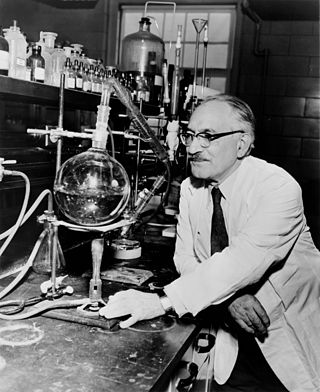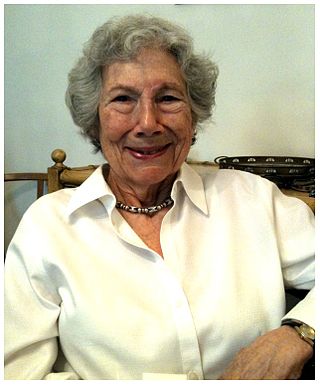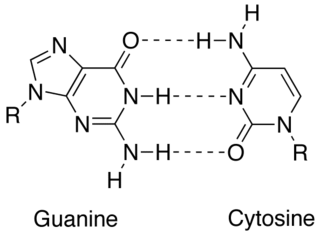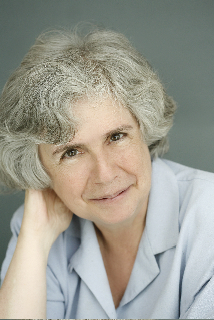Related Research Articles

Genetic recombination is the exchange of genetic material between different organisms which leads to production of offspring with combinations of traits that differ from those found in either parent. In eukaryotes, genetic recombination during meiosis can lead to a novel set of genetic information that can be further passed on from parents to offspring. Most recombination occurs naturally and can be classified into two types: (1) interchromosomal recombination, occurring through independent assortment of alleles whose loci are on different but homologous chromosomes ; & (2) intrachromosomal recombination, occurring through crossing over.

Chargaff's rules state that in the DNA of any species and any organism, the amount of guanine should be equal to the amount of cytosine and the amount of adenine should be equal to the amount of thymine. Further, a 1:1 stoichiometric ratio of purine and pyrimidine bases should exist. This pattern is found in both strands of the DNA. They were discovered by Austrian-born chemist Erwin Chargaff in the late 1940s.

In molecular biology and genetics, transformation is the genetic alteration of a cell resulting from the direct uptake and incorporation of exogenous genetic material from its surroundings through the cell membrane(s). For transformation to take place, the recipient bacterium must be in a state of competence, which might occur in nature as a time-limited response to environmental conditions such as starvation and cell density, and may also be induced in a laboratory.

Selman Abraham Waksman was a Jewish Ukrainian inventor, Nobel Prize laureate, biochemist and microbiologist whose research into the decomposition of organisms that live in soil enabled the discovery of streptomycin and several other antibiotics. A professor of biochemistry and microbiology at Rutgers University for four decades, he discovered several antibiotics, and he introduced procedures that have led to the development of many others. The proceeds earned from the licensing of his patents funded a foundation for microbiological research, which established the Waksman Institute of Microbiology located at the Rutgers University Busch Campus in Piscataway, New Jersey (USA). In 1952, he was awarded the Nobel Prize in Physiology or Medicine for "ingenious, systematic, and successful studies of the soil microbes that led to the discovery of streptomycin." Waksman and his foundation later were sued by Albert Schatz, one of his Ph.D. students and the discoverer of streptomycin, for minimizing Schatz's role in the discovery.

Sergei Nikolaevich Winogradsky (Russian: Сергей Николаевич Виноградский; Ukrainian: Сергій Миколайович Виноградський; 13 September [O.S. 1 September] 1856 – 24 February 1953), also published under the name Sergius Winogradsky, was a Russian microbiologist, ecologist and soil scientist who pioneered the cycle-of-life concept. Winogradsky discovered the first known form of lithotrophy during his research with Beggiatoa in 1887. He reported that Beggiatoa oxidized hydrogen sulfide (H2S) as an energy source and formed intracellular sulfur droplets. This research provided the first example of lithotrophy, but not autotrophy. Born in the capital of present-day Ukraine, his legacy is also celebrated by this nation.
Bernard David Davis was an American biologist who made major contributions in microbial physiology and metabolism. Davis was a prominent figure at Harvard Medical School in microbiology and in national science policy. He was the 1989 recipient of the Selman A. Waksman Award in Microbiology from the National Academy of Sciences.

Rolling circle replication (RCR) is a process of unidirectional nucleic acid replication that can rapidly synthesize multiple copies of circular molecules of DNA or RNA, such as plasmids, the genomes of bacteriophages, and the circular RNA genome of viroids. Some eukaryotic viruses also replicate their DNA or RNA via the rolling circle mechanism.
Julius Adler is an American biochemist. He has been an Emeritus Professor of biochemistry and genetics at the University of Wisconsin–Madison since 1997.

Richard Marc Losick is an American molecular biologist. He is the Maria Moors Cabot Professor of Biology at Harvard University and a professor at the Howard Hughes Medical Institute. He is especially noted for his investigations of endospore formation in Gram positive organisms such as Bacillus subtilis.

The Waksman Institute of Microbiology is a research facility on the Busch Campus of Rutgers University. It is named after Selman Waksman, a student and then faculty member at Rutgers who won the Nobel Prize for Medicine in 1952 for research which led to the discovery of streptomycin. The institute conducts research on microbial molecular genetics, developmental molecular genetics, plant molecular genetics, and structural and computational biology.

James Alan Shapiro is an American biologist, an expert in bacterial genetics and a professor in the Department of Biochemistry and Molecular Biology at the University of Chicago.

Evelyn M. Witkin was an American bacterial geneticist at Cold Spring Harbor Laboratory (1944–1955), SUNY Downstate Medical Center (1955–1971), and Rutgers University (1971–1991). Witkin was considered innovative and inspirational as a scientist, teacher and mentor.

Joachim Wilhelm "Jo" Messing was a German-American biologist who was a professor of molecular biology and the fourth director of the Waksman Institute of Microbiology at Rutgers University.
The Selman A. Waksman Award in Microbiology is awarded by the U.S. National Academy of Sciences "in recognition of excellence in the field of microbiology." Named after Selman Waksman, it was first awarded in 1968. A $5000 prize is included in the honor.

In molecular biology, complementarity describes a relationship between two structures each following the lock-and-key principle. In nature complementarity is the base principle of DNA replication and transcription as it is a property shared between two DNA or RNA sequences, such that when they are aligned antiparallel to each other, the nucleotide bases at each position in the sequences will be complementary, much like looking in the mirror and seeing the reverse of things. This complementary base pairing allows cells to copy information from one generation to another and even find and repair damage to the information stored in the sequences.
Simon Joseph Boulton is a British scientist who has made important contributions to the understanding of DNA repair and the treatment of cancer resulting from DNA damage. He currently occupies the position of Senior Scientist and group leader of the DSB Repair Metabolism Laboratory at the Francis Crick Institute, London. He is also an honorary Professor at University College London.
Richard High Ebright is an American molecular biologist. He is the Board of Governors Professor of Chemistry and Chemical Biology at Rutgers University and Laboratory Director at the Waksman Institute of Microbiology.
In molecular biology, hybridization is a phenomenon in which single-stranded deoxyribonucleic acid (DNA) or ribonucleic acid (RNA) molecules anneal to complementary DNA or RNA. Though a double-stranded DNA sequence is generally stable under physiological conditions, changing these conditions in the laboratory will cause the molecules to separate into single strands. These strands are complementary to each other but may also be complementary to other sequences present in their surroundings. Lowering the surrounding temperature allows the single-stranded molecules to anneal or “hybridize” to each other.

Susan Gottesman is a microbiologist at the National Cancer Institute (NCI), which is part of the National Institutes of Health. Gottesman has been the editor of the Annual Review of Microbiology since 2008.
R. John Collier is an American microbiologist and biochemist. He is the Maude and Lillian Presley Professor of Microbiology and Immunobiology, Emeritus at Harvard Medical School.
References
- Notes
- 1 2 American Academy of Arts and Sciences (2013). "Chapter B" (PDF). Book of Members: 1780–2012. Cambridge, Mass.: American Academy of Arts and Sciences. p. 36.
- ↑ "Playing With Biological Fire". The New York Times. 8 December 1969.
- ↑ Müller-Hill, Benno (2002). "The memoirs of an activist". EMBO Reports. 3 (11): 1022. doi:10.1093/embo-reports/kvf231. PMC 1307584 .
- ↑ Beckwith 2002, p. 224.
- ↑ "Selman A. Waksman Award in Microbiology". National Academy of Sciences. Archived from the original on 29 December 2010. Retrieved 27 February 2011.
- Bibliography
- Beckwith, Jonathan R. (2002). Making Genes, Making Waves: A Social Activist in Science . Harvard University Press. ISBN 978-0-674-00928-8.